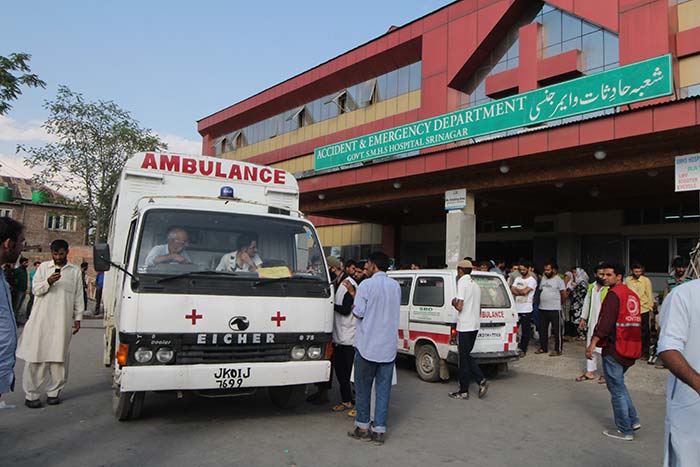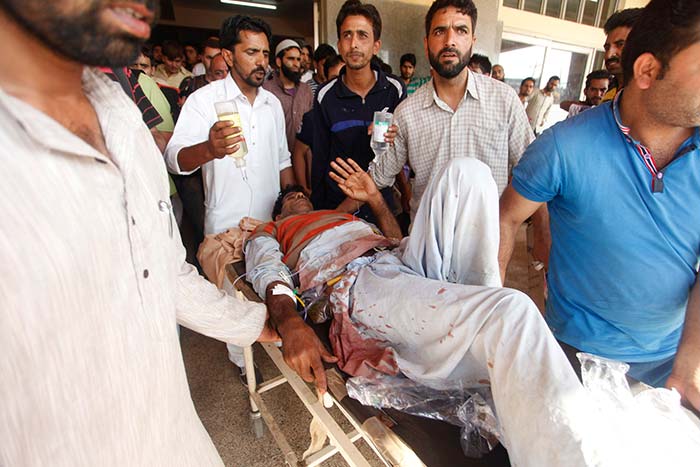Every time Kashmir streets turn into battlefields, hospitals struggled to manage the outcome. Working round the clock medical staff struggled to save the lives amid chaos and rising tempers, a Kashmir Life Team report

Every time streets become tense, hospitals are inundated. All of a sudden, the health centers become the most crowded spots across Kashmir. In the aftermath of Burhan Wani’s killing, casualties started pouring in hours before he was lowered in his grave. But what doctors’ saw was extraordinary.
“It was unexpected,” said a senior doctor at Srinagar’s Bone and Joint Hospital Barzulla, who is not authorized to speak. “It was a flood of injured with grievous wounds and it took us few hours of Saturday to realize that it was a war-like situation.”
Staff was summoned to duties, leaves were cancelled and all the 10 operation theatres (normally only two are in use) were opened.
In three days begining Saturday, Barzalla received 53 orthopedic cases, mostly firearm injuries. The injuries, which varied from torn muscles and fractures by bullets, had to be tackled on priority basis in order to prevent further damage. It has already gone for two amputations and now admitted would be given dates for major surgeries.
Battling firearm injuries, most of the injured currently admitted will survive with some disability.
Among them is Adil from Sogam, withering in pain. On Sunday, he says, as the protestors were chased by cops in his Lolab village, he got caught in concertina wire. “As I was struggling to free myself from clutches of wire,” says Adil, whose right leg was freshly operated upon, “the cops pounced on me and broke my leg by slamming it with continuous gun butts.”
In nearby bed, a boy from Pulwama — shot on his left leg — fears disability for only one simple reason: it will slow down the otherwise ‘swift cricketer’ on pitch. This fifteen-year-old boy who withholds his name fearing police profiling says he regrets that his ‘game’ has lost an edge.
Surgeon Dr Omar, who was part of the 45-member team of doctors, said the severity of injuries to civilians was worse than what he had seen during 2008 and 2010 unrest.

State government puts the number at more than 1600 but the numbers change. Kashmir’s tertiary care – SMHS, SKIMS and Bone and Joint Hospital, swells in crisis. But this time, the peripheral hospitals managed part of the load.
Pulwama, for instance, that 121 seriously and 325 minor injuries, could manage 93 cases (44 injured by pellets, 35 by shells and 14 by fire-arms) locally. Same was the case in Islamabad district hospital that got 123 bullet and pellet injured people. “We had six deaths in the hospital and in 19 cases we referred patients to Srinagar,” one senior doctor said. “But we carried out 26 major surgeries.”
“Part of the credit must go to our Director Health who would travel during nights to see the hospitals are working,” Dr Abdul Rashid Parra, who manages the district hospital in Pulwama. “I think he did not sleep for all these days as he would call us anytime 24×7.”
But the overwhelming crisis was visible in SMHS Hospital. There are two departments which have taken the maximum load of the ongoing unrest: the surgical care unit and the ophthalmology.
Every bed details a tragedy.
Sha and She (not real names) are cousins from a Bejbehara village. They were together when the cops fired on a mob. Explaining the crisis, senior surgeon Dr Javed said Sha was hit by pellets and not a bullet as she and her family believes. “I had to cut out a huge part of her bowl because the pellets fired at her from a very range had shattered it totally,” Dr Javed said. “The biggest saving grace has been that the pellets had somehow skipped the foetus she was carrying.”
Unlike Sha, She is in coma. Not only her eyes but also her spinal cord is seriously damaged. Doctors do not see a hope in her state of health.

Not far-off away from her village lives a young man Jun, not the real name, who is also admitted to the same ward. He has barely completed his matriculation. “His penis was so badly damaged by the pellets that I have already amputated it,” a senior doctor said. “You may be shocked that a bullet is still in his testicle sack and has already destroyed one.”
Then the doctor points towards another young boy whose scrotum is completely damaged. Part of the surgery is over but he may require more, the doctor said. Scrotum is the testicle sack.
“It is pretty dangerous to manage a pellet injury,” Dr Javed said. “Unlike bullet that has one injury, pellets can have a 100. We lost a young man because a pellet fired from a very close range had entered the heart.”
Dr Javed said the worst about pellets is that the victims can never be tested through CT Scans and MRIs because they might still be carrying small pellets that skip the surgeon’s knife. “It is inhuman to use pellets,” he insisted.
SMHS’s ophthalmology department got the massive patient influx of its history. “We got more than 90 cases the same night,” Dr Afroz Khan. “We had to create space that was an additional challenge.”
“We were a team of 30 doctors and all of them worked 24×7. Many of us haven’t been home since the eruption of violence,” a senior ophthalmologist said.
But the crisis on medical front was outside the hospital. It was the movement of patients to the hospital that was greatly hindered. Doctors say the trauma patients have just one hour for better management. They call it “the golden hour”. In most of the cases, this hour is lost in transit.
For patients and their attendants, the biggest struggle after being injured was to reach the hospital, especially to Srinagar. While in two cases – one each in Pampore and Bijebhara, the cops stopped the ambulances and delayed their arrival to the hospital that eventually led to their deaths later, almost every second patient in SMHS tells a story of marshalling and humiliation. There are patients who were beaten more than once before landing on the operation table.
Health department said as many as 60 ambulances were attacked and damaged. Though it did discourage ambulance drivers but they fought back, they started wearing helmets to drive down injured to Srinagar.
Once they landed in the hospital, another tier of the police set up was getting active. Sleuths would start recording the influx – the patients, their names and the nature of their injuries and other details. At the face of it, it seemingly is a legitimate exercise. But people believe that this was being done to profile them so that they are arrested later after formal cases are registered against them.
During this unrest, a pathetic case surfaced. The day Shabir, a mason was brutally killed by the police, another young man Hilal Ahmad received a serious head injury when CRPF hit his head. The family rushed him to SKIMS and the fear that they will be booked forced them to tell the hospital that he was injured in a road accident! Hilal died later.
“Officially he is an accident case,” a senior hospital functionary said. “But the fact is that he was hit by CRPF, rest is your job.”
This crisis surfaced officially in a meeting in Pulwama when Finance Minister Dr Haseeb Drabu presided a meeting and asked about why lot many people directly drive to Srinagar. “Basically, I asked about the referrals to Srinagar and they said the people avoid staying in the hospital because they fear they will be arrested by the police,” Drabu told Kashmir Life. “I have asked police, both the executive police and the CID, to avoid getting into the hospital as it creates panic and pushes the referrals to SMHS and other hospitals.”
But people admitted in the SMHS have the same story to tell.















